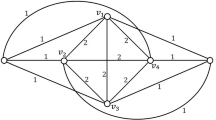Abstract
We study simple algorithms for the balanced MAX 2SAT problem, where we are given weighted clauses of length one and two with the property that for each variable x the total weight of clauses that x appears in equals the total weight of clauses for \(\overline{x}\). We show that such instances have a simple structural property in that any optimal solution can satisfy at most the total weight of the clauses minus half the total weight of the unit clauses. Using this property, we are able to show that a large class of greedy algorithms, including Johnson’s algorithm, gives a \(\frac{3}{4}\)-approximation algorithm for balanced MAX 2SAT; a similar statement is false for general MAX 2SAT instances. We further give a spectral 0.81-approximation algorithm for balanced MAX E2SAT instances (in which each clause has exactly 2 literals) by a reduction to a spectral algorithm of Trevisan for the maximum colored cut problem. We provide experimental results showing that this spectral algorithm performs well and is slightly better than Johnson’s algorithm and the Goemans-Williamson semidefinite programming algorithm on balanced MAX E2SAT instances.
A. Paul—Supported by an NDSEG fellowship.
M. Poloczek—Supported by the Alexander von Humboldt Foundation within the Feodor Lynen program and by NSF grant CCF-1115256.
D.P. Williamson—Supported in part by NSF grant CCF-1115256.
Access this chapter
Tax calculation will be finalised at checkout
Purchases are for personal use only
Similar content being viewed by others
References
Argelich, J., Li, C.M., Manyà, F., Planes, J.: MAX-SAT 2014: Ninth Max-SAT evaluation. www.maxsat.udl.cat/14/. Accessed 9 January 2015
Austrin, P.: Balanced MAX 2-SAT might not be the hardest. In: STOC, pp. 189–197 (2007)
Belov, A., Diepold, D., Heule, M.J., Järvisalo, M.: Proceedings of the SAT COMPETITION 2014: solver and benchmark descriptions (2014)
Buchbinder, N., Feldman, M., Naor, J., Schwartz, R.: A tight linear time (1/2)-approximation for unconstrained submodular maximization. In: FOCS, pp. 649–658 (2012)
Chan, S.O., Lee, J., Raghavendra, P., Steurer, D.: Approximate constraint satisfaction requires large LP relaxations. In: FOCS, pp. 350–359 (2013)
Feige, U., Goemans, M.X.: Approximating the value of two prover proof systems, with applications to MAX 2SAT and MAX DICUT. In: ISTCS, pp. 182–189 (1995)
Goemans, M.X., Williamson, D.P.: New 3/4-approximation algorithms for the maximum satisfiability problem. SIAM J. Discrete Math. 7(4), 656–666 (1994)
Goemans, M.X., Williamson, D.P.: Improved approximation algorithms for maximum cut and satisfiability problems using semidefinite programming. J. ACM 42(6), 1115–1145 (1995)
Johnson, D.S.: Approximation algorithms for combinatorial problems. J. Comput. Syst. Sci. 9(3), 256–278 (1974)
Khot, S., Kindler, G., Mossel, E., O’Donnell, R.: Optimal inapproximability results for MAX-CUT and other 2-variable CSPs? SIAM J. Comput. 37(1), 319–357 (2007)
Lewin, M., Livnat, D., Zwick, U.: Improved rounding techniques for the MAX 2-SAT and MAX DI-CUT problems. In: Cook, W.J., Schulz, A.S. (eds.) IPCO 2002. LNCS, vol. 2337, pp. 67–82. Springer, Heidelberg (2002)
Matuura, S., Matsui, T.: \(0.935\)-approximation randomized algorithm for MAX-2SAT and its derandomization. Technical report METR 2001-03, Department of Mathematical Engineering and Physics, the University of Tokyo, Japan (2001)
Poloczek, M.: Bounds on greedy algorithms for MAX SAT. In: Demetrescu, C., Halldórsson, M.M. (eds.) ESA 2011. LNCS, vol. 6942, pp. 37–48. Springer, Heidelberg (2011)
Poloczek, M.: Greedy Algorithms for MAX SAT and Maximum Matching: Their Power and Limitations. Ph.D. thesis, Johann Wolfgang Goethe-Universitaet, Frankfurt am Main (2012)
Poloczek, M.: An experimental evaluation of fast approximation algorithms for the maximum satisfiability problem (2015) (in preparation)
Poloczek, M., Schnitger, G.: Randomized variants of Johnson’s algorithm for MAX SAT. In: SODA, pp. 656–663 (2011)
Poloczek, M., Schnitger, G., Williamson, D.P., van Zuylen, A.: Greedy algorithms for the maximum satisfiability problem: simple algorithms and inapproximability bounds (2015) (in preparation)
Poloczek, M., Williamson, D.P., van Zuylen, A.: On some recent approximation algorithms for MAX SAT. In: Pardo, A., Viola, A. (eds.) LATIN 2014. LNCS, vol. 8392, pp. 598–609. Springer, Heidelberg (2014)
Soto, J.A.: Improved analysis of a Max-Cut algorithm based on spectral partitioning. SIAM J. Discrete Math. 29(1), 259–268 (2015)
Trevisan, L.: Max Cut and the smallest eigenvalue. SIAM J. Comput. 41(6), 1769–1786 (2012)
Yannakakis, M.: On the approximation of maximum satisfiability. J. Algorithms 17(3), 475–502 (1994)
van Zuylen, A.: Simpler 3/4-approximation algorithms for MAX SAT. In: WAOA, pp. 188–197 (2011)
Author information
Authors and Affiliations
Corresponding author
Editor information
Editors and Affiliations
Appendices
A Soto’s Bound for MAX CC
Recall from Sect. 4 that \(\mathrm {LB}_{G}(\varepsilon )\) is a lower bound on the fraction of weight achieved by Trevisan’s spectral algorithm on G, where G is the MAX CC instance that was created by our reduction on the balanced set of 2-clauses C.
Lemma 2
(Sect. 3.1 in [19]). Let \(\varepsilon _0\) be the unique solution of the equation \(\frac{1}{1 + 2 \sqrt{\varepsilon (1- \varepsilon )}} = \frac{ -1 + \sqrt{4 \varepsilon ^2 - 8 \varepsilon + 5}}{2 (1-\varepsilon )} .\) Then,
If \(\varepsilon \ge \frac{1}{3}\),
If \(\varepsilon _0 \le \varepsilon \le \frac{1}{3}\),
If \(\varepsilon \le \varepsilon _0\),
B Dependency of the Approximation Ratio on \(\alpha \) and \(\beta \)
Rights and permissions
Copyright information
© 2016 Springer-Verlag Berlin Heidelberg
About this paper
Cite this paper
Paul, A., Poloczek, M., Williamson, D.P. (2016). Simple Approximation Algorithms for Balanced MAX 2SAT. In: Kranakis, E., Navarro, G., Chávez, E. (eds) LATIN 2016: Theoretical Informatics. LATIN 2016. Lecture Notes in Computer Science(), vol 9644. Springer, Berlin, Heidelberg. https://doi.org/10.1007/978-3-662-49529-2_49
Download citation
DOI: https://doi.org/10.1007/978-3-662-49529-2_49
Published:
Publisher Name: Springer, Berlin, Heidelberg
Print ISBN: 978-3-662-49528-5
Online ISBN: 978-3-662-49529-2
eBook Packages: Computer ScienceComputer Science (R0)





